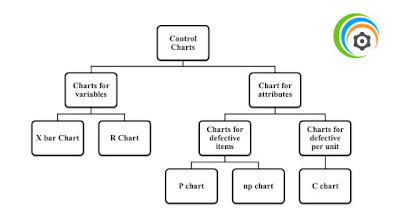X-bar Chart & R chart
The X-bar chart is a type of control chart that is used to monitor/measure the arithmetic means of succeeding samples of constant size (n). It is used to measure characteristics of a continuous scale, such as temperature, thickness, weight etc.
Example
The below table gives the measurement of axles of bicycle wheels. Find whether process is in control or not.
(Hint: It is given as measurement from which we came to know it’s an X bar chart and R chart. We need to find mean and range to measure any quantity.)
|
Sample
|
Value of sample
|
X bar
|
Range
|
|
1
|
139,140,145,144
|
142
|
6
|
|
2
|
140,142,142,139
|
140.75
|
3
|
|
3
|
142,136,143,141
|
140.5
|
7
|
|
4
|
136,137,142,142
|
139.25
|
6
|
|
5
|
145,146,146,146
|
145.75
|
1
|
|
6
|
146,148,149,144
|
146.75
|
5
|
|
7
|
148,145,146,146
|
146.25
|
3
|
|
8
|
145,146,147,144
|
145.5
|
3
|
|
9
|
140,139,141,138
|
139.5
|
3
|
|
10
|
140,140,139,139
|
139.5
|
1
|
|
11
|
141,137,142,139
|
139.75
|
5
|
|
12
|
139,140,144,138
|
140.25
|
6
|
X bar= 142.125, R bar= 4.083
X-bar chart
UCL=145.11
LCL=139.15
R chart
UCL=9.31
LCL=0 (if LCL is negative, it should be considered as zero)
The below are control charts of X bar and R-chart.
There are four responses outside the control so, the process should be stopped and cause should be identified.
The R-chart all responses are within the control. Hence, the whole process is in control.
 |
| X-bar Chart |






